The first chapter of a series devoted to the opening of Michelin-starred chef Curtis Duffy’s Grace. (7:09)
 |
|

The first chapter of a series devoted to the opening of Michelin-starred chef Curtis Duffy’s Grace. (7:09)

Guess I didn’t behave too badly, they invited me back…
There’s nothing people love more than to read about their own impending doom, and so Amanda Hesser of Food52.com got a lot of FaceTwit attention last week for this piece about how becoming a food writer sucks these days. Actually the piece goes on to lay out a positive Internet-futuristic vision that makes a lot of sense and is well worth thinking about, but nobody seemed to pay any attention to that. They just glommed onto the part about how it’s hopeless to think you’ll make a decent living as a full-time food writer in the traditional sense, and wallowed in it for a day or two online.
I thought about how to express my thoughts on this and started about three or four different opening sentences, but finally decided a Venn diagram expressed my opinions best:
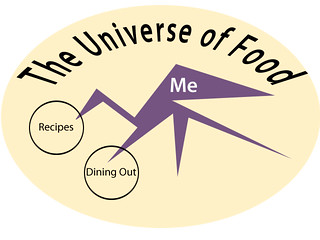
I don’t mean that I’m some multidimensionally fascinating being who’s too big for the traditional world of food writing— I’m just saying that my interests range considerably, as I expect yours do too. And anybody who wants work is going to have to figure how to make money out of the degree to which what motivates them overlaps with what the marketplace buys.
But where that was a fairly defined (and maybe even hidebound) set of things a few short years ago, when monopoly dailies were making money hand over fist, now we’re in a time when you can experiment with what seems cool to you and it may overlap with what someone else wants to do to shake things up too and suddenly, no, you don’t have a traditional food journalism job, you have an entirely new one that didn’t exist at all until you helped invent it. Indeed, Amanda Hesser basically said exactly that: “If I weren’t working on Food52, I would not be a full-time writer because, even as an experienced journalist and best-selling author, I would not be able to pay my bills.” Which makes it sound like she was forced to fall back on Food52 when in fact she invented something new and has made quite a success out of it. When it ought to be more like, “If I was still a full-time writer doing the standard assignments, I’d never have invented Food52.” At least I hope she thinks of it that way; I do.
* * *
Speaking of a job that pretty much didn’t exist until I invented it for myself, I have a lot of chef video things going on; I started a new series at Grub Street about Grace, Curtis Duffy’s restaurant which will open later this year (maybe). I’ll be checking in with him from time to time as the restaurant develops on its path to being the next four-star (they hope!) top level swank joint in town:
And I haven’t posted Key Ingredients for a while, so here are the last three, oldest to newest. We went inside The Office, Next’s private lounge, with Craig Schoettler (story is here):
Then he picked Charles Joly of The Drawing Room (story here):
I thought we might be doing mixologists for a while, but Joly picked Giuseppe Tentori (we shot at GT Fish & Oyster; story here):
* * *
And it’s a new quarter so time to tally up the best things I’ve eaten since the start of the year (I didn’t stop at March 31st, so this runs up right to this morning):

• Pork tamale from in front of St. Francis of Assisi church
• Mortadella from Smoked Goose, Indianapolis (at Dose Market)
• Manila clams with merguez broth, Purple Pig
• Sardines in saor, other stuff, Bar Ombra
• Surryano ham, some cheese from Minnesota with honey and apple salad, 2011 Commanderie de Peyrassol rosé, Telegraph
• Parsnip cake dessert, Storefront Company
• Chicken and waffles with onions and gravy, Chicago’s Home of Chicken & Waffles
• Honey panna cotta, Eating Vincent Price/Clandestino popup dinner
• Wheatberry/risotto with asparagus and ramps, Browntrout
• Sturgeon with buttermilk sauce/spaetzle, Blackbird
• Maple and citrus glazed black cod, Brittany Coast John Dory with sunchokes and Cote du Rhone reduction, Sixteen
• Rare tender beef salad, Nha Hang
• Ramova chili (what can I say, I only ever went there for breakfast before now…)

• Wisma corned beef sandwich, French Market
• White pizza, Jimmy’s Pizza & Beignets
• Crispy tripa taco, La Chapparita
• Indian spiced sturgeon, some other fish I forget, Sepia
• White anchovies, Vera
• A taste of blood sausage at Publican Quality Meats in someone else’s stew or soup, I liked the sandwiches fine but this made them kneel before it
• Little bit of everything sandwich (Ellen Malloy dubbed it “Goutwich”) at Butcher & Larder with amazing crispy mortadella on it
• Chicken, bacon and leek (cock-a-leekie) pie at Pleasant House Bakery
• Brussel sprouts and kielbasa, tagliatelle with duck or something like that, Allium (preview dinner)
• Lamb ribs, Lockwood
• Lobster roll, New England Seafood Market
• Breaded steak sandwich, Johnnie O’s
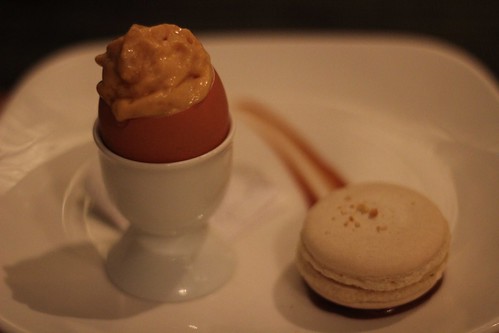
• Egg custard dessert, clay pot chicken, Takashi
• Dessert at Yusho
• Shima Aji, Anise hyssop, Oyster courses, EL Ideas
• Caiprinha, spherical olive, carrot foam, miso cake, mint pond courses, Next El Bulli menu
• Calves’ foot jelly, pearl onion mutton soup, Kentucky tavern dinner, Big Jones
• Biscuits & gravy, Don’s Humburgers
• That’s-a-Burger

I’ve sometimes made reference to “Finedininglandia” or some other term representing the fact that wherever you are in the world, there’s a kind of international “country” of fine dining that transcends place. This is only natural because it’s a jet-connected world where chefs pop into each others’ restaurants around the globe, read the same books or articles about the same techniques, etc. So what one chef does in Oslo, soon becomes what chefs from San Diego to Sao Paolo are playing with. That doesn’t mean there’s no difference— obviously there is if there’s any sort of localism to the food— but nonetheless, as Walt sagely put it, it’s a small world.
I hadn’t really thought about the temporal rather than the spatial version of that that much, although it’s obviously the case— if everyone in 2012 is doing a certain thing, that means all restaurants are different even from themselves in 2008, say, when they were all doing a certain other thing. The reason I didn’t think about that, I’m sure, is that you can’t pop in to, say, Blackbird five or ten years ago and see how it’s different from Blackbird now. What’s the point of thinking about it if you can’t eat it? But I just wrote a review about a place (Urban Union) that I thought was kind of 2008 all over again, and if that sounds like a slam, I enjoyed revisiting 2008 again, having it to contrast with 2012. Some of how food has changed since then is more refined, but some of it is less focused than the simplicity of big porky flavor pops, which seemed to be all the rage then. So going back to 2008 was both instructive— and simply pleasurable.
I mentioned Blackbird because I went to a dinner there a couple of weeks, sponsored by Tasting Table (whose guest I was), that aimed to recreate the original Blackbird c. 1998-9 when it opened. Now that’s really going back in time— there are many restaurants still serving largely what they served then, I’m sure but Blackbird is one that has done so much to change the world it works in that its menu of 12 years ago is truly an act of historical reconstruction. Local produce is so much more common and available now, the idea of eating funky cuts is so much more common now (thanks in no small part to Blackbird famously popularizing pork belly and the like). But Blackbird has also changed, become more refined under Paul Kahan’s successive chefs de cuisine— more a citizen of Finedininglandia. (Listening to Paul Kahan talk that night about getting Blackbird open back in the day, you realize that apart from chic decor and location, it was kind of more like a hippie cafe in spirit than the typical fine dining of the day, with its emphasis on fairly straightforward ingredients rather than all the chic frou-frou of the time.)

Anyway, we had a three course meal of dishes from the early menu, including a sturgeon dish with spaetzle, housemade pickles and a buttermilk sauce, and a knackwurst and sauerkraut dish. Kind of amazing to think that a chic white restaurant then was serving hearty German food in the latter case, and in the former case, outright Jewish food. I knew Paul Kahan’s dad had had a fish smoking company, and deep down his connection to simple meaty ingredients came out of his growing up around the meatpacking district (he talks about that in my latest video) but never before had I had something at Blackbird that came so directly out of a Jewish fish merchant-and-deli milieu. And you know what? I loved it and I instantly wished that there was more of that on the menus of his empire. Why shouldn’t there be smoked fish at Publican Quality Meats next to chorizo and blood sausage? Paul Kahan’s the last guy who needs me or anybody to tell him what he should be cooking, but I’d love to have a Jewish Blackbird pop up some more, somewhere on the menus of his various places. In this case, seeing a little of Blackbird in 1999 opened the door to a whole world of Chicago food culture history beyond it.
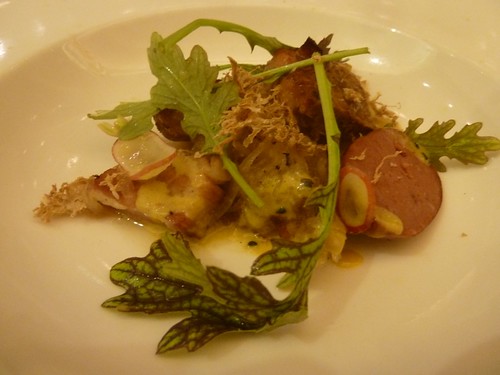
* * *
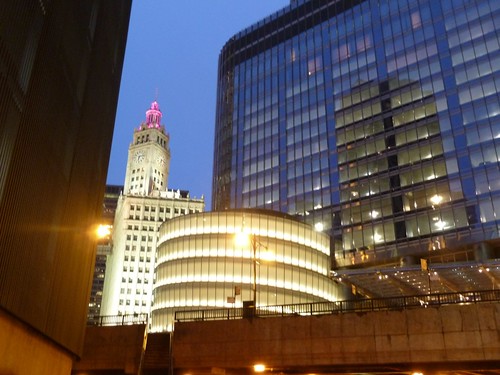
I had another flash from the past at another meal. Sixteen is the restaurant in the Trump International Hotel & Tower. As you might expect, this is nosebleed-pricing fine dining land in every way, a very expensive menu, a grand dining room with a two-story sweeping wall behind it, a chef (Thomas Lents; I interviewed him here) who got his start at Everest but has worked all over the world for people like Joel Robuchon, and a pretty-much-admitted mission to land three Michelin stars, cost be damned. (I was a media guest. Needless to say.)
What’s interesting is that although it’s plainly modern food, it’s not modernist food— there’s only the slightest dabbling in foams, and no powders or other strange transformations happening here. Which makes me wonder— is there room in Michelin’s universe, and in that of diners for whom fine dining has come to mean Alinea’s and Next’s bag of magic tricks, for straightforward food at the highest level? Because this was, unquestionably, at the highest level, refined to a delicacy so exquisite that the only other place I’ve experienced anything like it lately was, indeed, during my sampling of the Next El Bulli menu. The difference is, when Next gave me a carrot dish that downright sang with the intensity of the purest carrot flavor, it was a space-age El Bulli concoction, disembodied carrot foam in a glass bubble. Where at Sixteen, Lents simply made carrot soup, physically as anyone might make carrot soup for a piece of Dover sole to sit in. (The sole was, incidentally, the one off thing of the night— tougher than it surely ought to have been, especially resting amid carrot evanescence.)
I have a menu and could list specific dishes but you know, they’re all composed plates consisting of several different tastes; it wouldn’t tell you that much to rattle them off. What I can say is that, at least eight times out of ten, they tasted intensely, almost fluorescently of themselves, the most radishy or gingery or black coddy a thing ever tasted. (The plates were also often fluorescently colorful as well, like the aftermath of an Easter Egg accident.) What it suggested to me is what Charlie Trotter’s must have been like 25 years ago. Not, I think, that Lents’ food is much like Trotter’s (though it might well be more like it than it’s like Alinea’s) but people who ate at Trotter’s back then felt that they tasted things, truly tasted them for the first time back then when he made them— surely as pivotal a moment in the making of our modern food scene as their first taste of pork belly at Blackbird. Without being like Trotter’s actual food necessarily, Lents’ food at its best was like tasting these things for the first time (even the one I’d just tasted for the other first time at Next). Lents is not exactly a locavore, though he is definitely buying things at peak season somewhere on the globe; for instance one vegetable, I forget which, was coming from Florida, from a farm next to where his parents live.
So if this is the Trotter of 2012, will that draw the crowds in 2012 without Alinea/Next conceptual pyrotechnics? I guess the Donald can gamble on that; so far Lents hasn’t gotten a lot of attention for what he’s doing, but maybe they’re just playing the long game and don’t feel the need to battle Nellcote and Balena to be restaurant of the moment. If you have the money— a big if— and are okay with the atmosphere of the vast hotel dining room (great view, leaves you feeling a little like the small fish in the very big tank), Lents is making gorgeous, exquisitely well-crafted food that deserves to be tried, even if only to know what a major hotel company’s best guess at what Michelin and its international audience of well-heeled diners will love looks and tastes like.
Tags: blackbird, sixteenWE PULL UP ON A SIDE STREET near the Merchandise Mart. There’s a small group of people already waiting, each with a smart phone in one hand, a paper or plastic bag in the other. In the bag might be tamales from the Tamalli Spaceship, mac and cheese from The Southern, or sausage from the Haute Sausage truck. Jared Forratt, a lanky twentysomething with a scraggly beard and tattooed “sleeves” running up both arms, pulls the emergency brake, makes his way to the back of the white truck and opens the window. The first person in the crowd walks up, clutching three ones. “Uni shooter,” he says.
Forratt goes to work, setting out a shot glass, then splashing the inside of the glass with aquavit. Deftly he cuts a sea urchin out of its spiny shell and plops it into the glass; then he grates fresh horseradish onto it and places a single slice of candied kumquat on top. He sets it on the ledge of the window and plucks the three dollars from the man’s hand. The customer takes the shot glass, knocks it back in a single motion, and sets the shot glass back down. “That was beautiful, man,” he says. Forratt just gives him the slightest nod, and then points to the next customer.
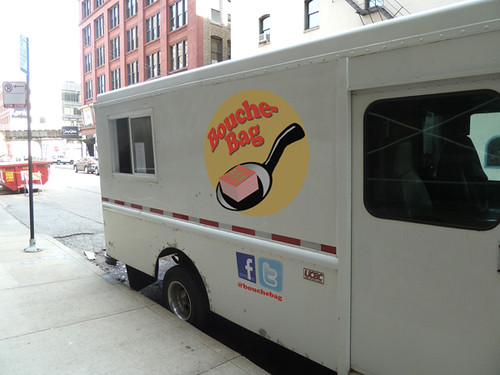
Forratt is the proprietor of Bouche-Bag, the world’s first amuse-bouche truck. From his earliest days cooking, he was intrigued— maybe obsessed— by that tiny first bite of the meal offered gratis as a welcoming gesture in fine dining restaurants. “Everyone deserves to have their meal start out with something great,” Forratt says. “An amuse-bouche is like a ticket to adventure.” He soon became famous in Chicago restaurant circles as the master of the form— sometimes beyond practicality. “I’ve got three guys waiting to get at the fryer, and Jared’s taken it over, battering and frying individual microgreens that he’s holding in the oil in his tweezers,” Rick Tramonto recalls of Forratt’s tenure at Tru. “He’s an artist, no question about it, but at 7:00 on Friday night I gotta use my kitchen to make things people actually pay for.”
After a tempestuous history with many of the city’s top restaurants— Trio, L2O, Graham Elliot, The Black Sheep— and repeated struggles with chefs who, he felt, compromised his vision for “an amuse-bouche that, as Aldous Huxley said, opened the doors of perception,” Forratt was talking with Phillip Foss, then operator of the Meatyballs Mobile. Foss, jokingly, pointed out that the city code which prevented food trucks from preparing food on board defined prepared food as multiple ingredients put together in a dish to be eaten in multiple bites. Therefore an amuse-bouche, which is designed to be eaten in a single bite, was technically not food for the purposes of the regulations. Excited by the prospect of doing amuse-bouches exactly as he wanted to, without the distraction of other chefs or a restaurant, Forratt quickly found a backer from among the fans who had followed his work over the years from one four-star place to the next, and at last he had his own rolling establishment where he could offer amuse-bouches that met his precise vision, directly to diners.
IT’S 12:34, AND WE’RE A FEW minutes late for a rendezvous at the Aon building. The line is about 15 deep, all clutching bags— Pret-a-Manger, Au Bon Pain, Taco Bell. I ask Forratt if it bothers him that his beautifully-crafted amuse-bouches are often followed by fast food. “No, man. An amuse-bouche is a promise; it’s not my problem if it’s a promise that the rest of your meal can’t keep.” Today on the menu he’s got three choices, each priced at $3: the uni shooter, a stamp-sized square of Arctic char on a cauliflower semifreddo with pickled Japanese turnip, candied blood-orange peel and radish sprouts, and a spelt cracker with ahi aioli, hazelnut dauphinoise soil and mung-lychee sorbetto.

The Arctic char amuse.
Forratt works amazingly fast, “plating” each onto a plastic spoon or other utensil with tweezers in less than a minute. Yet not a piece looks out of place, and the buyer receiving each handcrafted jewel holds it carefully, almost reverently, before downing it and then getting on with his chicken salad on Asiago roll or Doritos Locos taco. I ask one customer, graphic designer Wade Murdock, why he’s willing to pay $3 for a single bite of food. “I thought it was crazy, too, but as soon as I had one bite— which is all there was, one bite— of his pork belly niçoise with wasabi poutine gelee and banh mi smoke, I was hooked,” Murdock says. “It’s worth $3 for something that really sets up your slice of Sbarro’s so perfectly.”
Despite the high price, Forratt admits that he’s barely breaking even on the amuse-bouches; he’s thinking of adding a line of palate cleansers to his menu, so that customers might come back during the same lunch for a single spoonful of Thai lemongrass gelato, say. But at the same time, he curses himself out for even thinking of compromising his vision of the perfect amuse-bouche. “The most exquisite moment is the one right before you take that first bite, when all the possibilities and wonder of the meal are before you,” he says. “If I could, I’d sell you that moment, and then drive away as fast as I can before you ruin it by actually eating.”
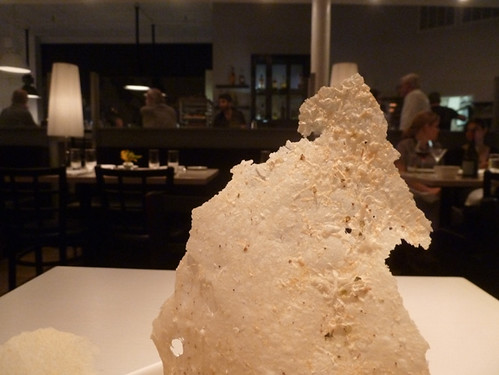
Been to a ton of places lately, haven’t written about them, working backwards through my photos, here’s shortish reviews of a number of them.
Storefront Company— Chic, black and white place on a seemingly unlikely strip near the recent-college-grad drinking epicenter of North and Damen. My first thought was “Blackbird for stroller moms,” but actually given the neighborhood, by the end I was thinking more like Acadia— not that there’s any resemblance between Acadia’s post-industrial-wasteland gentrifying neighborhood and busy-trashy Wicker Park, but there’s a similar mission of, who says you have to go downtown for luxe fancy food and pay crazy prices for it?
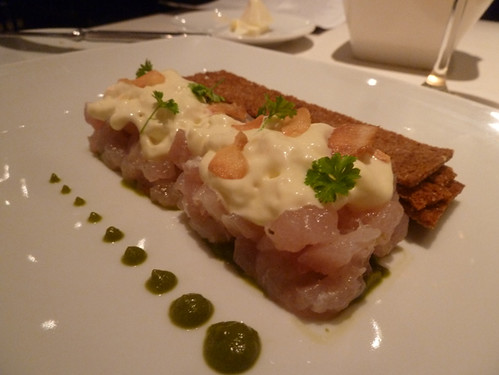
Albacore with clam mousse.
Chef Bryan Moscatello, who was a Food & Wine Best New Chef in Denver and then spent a long time in D.C., makes lush food which looks to impress, but sometimes needed more of a flavor pop to compete with Chicago places, I think— it felt a bit like fancy food from somewhere else. An albacore tartare was gorgeous but the clam mousse on it didn’t have any real taste of the sea to it, damping it down; I did like the boldness of the garlic chips on it, though. A pork cheek hash with gooey six-hour sous-vide egg was the sort of thing where fancy touches don’t bring as much to it as just normal cooking— a diner cook frying the pork and the egg to a little browned crispness would have gotten more flavor out of both. And as far as I’m concerned, six-hour eggs are one of those things, like most malto-dextrin powders, that fall into the “just because you can doesn’t mean you should” camp. (Again, though, there was some daring in the crispy accompaniment on top, which were announced, simply, as what they were: fried chitlins.)
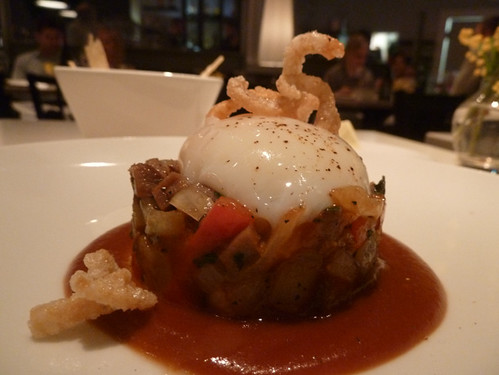
Pork cheek hash with six-hour egg.
But rabbit, treated sort of like a galantine and topped with several generous slices of black truffle, showed that they do know how to sharpen a dish to a flavor point, and though I had resisted the waiter’s fairly insistent pushing of the cheese program, when they sent me out an epoisses anyway (and a glass of white wine to go with it), it was a gorgeous, unabashedly smelly one that blended beautifully with the wine they chose. And the dessert was simply one of the best I’ve had in recent memory, a sweet-savory parsnip cake with cream cheese ice cream, a savory thyme-golden raising sauce, and little dabs of a tart “carrot caramel,” more harmoniously balanced between sweet and savory than you would ever think it could be.
This is an ambitious restaurant way above its neighborhood-place footprint and location— they have their own baking program making breads and mignardises and such, which is more like what a big hotel restaurant would do than a 60-seater in the middle of a block— and even if some of it seemed flash over substance (in a way that you can believe went over in D.C.), it’s at reasonable enough prices that you can afford to experiment to find some undeniable gems. (Disclosure: media dinner, fully comped.)

Parsnip cake.
Urban Union— Do you remember 2008? The heyday of the porky big flavors movement, places like Vie and Mado and Avec making their own salty porcine wonderfulness and putting it in everything, from main courses to vegetables? It’s not that that has exactly gone away, of course, but something about Urban Union, a new place on Taylor Street run by Michael Schrader (formerly of Epic, which I never went to), seemed to bring back those days in a way that wasn’t subtle— there was nothing subtle about the pool of balsamic that my brussels sprouts with pancetta left behind— but was easy to enjoy, and made Urban Union an instant feels-like-it’s-been-there-forever place. (The logo actually says “Est. 1997,” but that’s when Schrader and partner Jason Chan met.)
The downside to this cheerful unsubtlety is that there’s a bit of an unrefined, almost careless feel to some of the dishes— a mussels dish promised something new with Spanish chorizo and so on in it, when it was well-made but pretty standard, and the most interesting dish at first bite, a tagliatelle with pancetta (pancetta’s everywhere), sage and parmesan, was way too salty to eat much of; I suspect it was adjusted for salt before the salty parmesan was added as well. Apparently it takes more a little more effort than this to get effortlessness just right. (Disclosure: none.)
Yusho— I am, apparently, the only person on the entire Chicago food media scene who wasn’t instantly smitten by Yusho, Matthias Merges’ Japanese bar-izakaya-whatever. I went in (on Super Bowl Sunday) prepared to love it, prepared to at last find Chicago’s answer to Yakitori Totto, but it didn’t happen. Oh, there’s no doubt that things are well-made, as you’d expect from a Trotter vet; we sat at the omakase seats overlooking the cooks as three young women spent our entire meal smoothing out chicken skin onto plastic wrap, an unmistakable sign of care (and how boring line cook jobs could be). I don’t doubt the skill and devotion, but things just didn’t taste that great, it was the opposite of Yakitori Totto where the soap in the washroom would have made my ten best list. I don’t remember all that much now, but take the fried chicken, big chicken fingers (that’s whose skin we were watching being flattened) fried like fried chicken and then dashed with some green nori-type powder. Some people love it; to me it was like dipping my chicken fingers in the goldfish’s food.
Nothing was that great until we got to dessert— and suddenly the place blossomed for me. I loved a dessert built around a custard made from kalamansi, a tart Asian citrus; and a tongue-pricking Sichuan peppercorn frozen custard. With so much acclaim from every corner I’ll try Yusho again— but I’m willing to do that because I know if nothing else, there will be a reward at the end. (Disclosure: none.)

Mi quang noodles.
Nha Hang— Once in a while LTHForum takes time off from criticizing the reservation process at Next to work the way it was designed to work, and this one end-to-the-other exploration of Vietnamese food on Argyle street was one of the best examples in recent memory. The clear winner and new discovery to come of the effort was this family-run spot near the eastern end of the strip, and trying some of the LTH-scouted things, it’s quite good— I especially liked rare (it wasn’t, but never mind) beef salad, which had a Thai food-like limey-juiciness, woven rice wraps with terrific grilled beef and shrimp, and bun mam, a rich broth soup. (The one LTH recommendation I tried and was just okay on was the Mi quang noodles; curry-flavored noodles with lots of peanut, it just tasted like middling pad thai.)
The only caveat I’d add to the chorus of LTH praise is that while I liked the cleanness of the broths and flavors, which was almost Japanese in its purity, I also kind of like some funk in my Asian soup, or a lot of funk in it, and this isn’t the place for that so far as I could see. So it doesn’t replace, say, the bun bo hue at Cafe Hoang (thanks Dan Schleifer for the tip), which is almost satanically, Ike Turner-funky by comparison. LTH has a tendency to settle on one place as the place for a cuisine, to the detriment of seeking out others; Tank Noodle was it for Vietnamese for years, and I think the proper response to discovering Nha Hang is not to topple Tank and crown Nha Hang in its place, but to take the lesson, enjoy Nha Hang as presenting one side of the cuisine very well— and keep hunting.
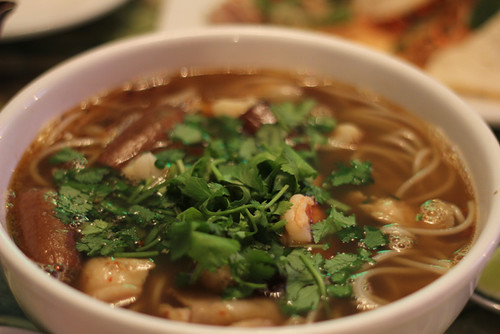
Bun mam.

Jimmy’s Pizza Cafe & Beignets— Clean flavors were also the hallmark of another place nominated for an LTHForum Great Neighborhood Restaurants award this season, a New York-style pizza cafe on north Lincoln (which for some reason has New Orleans-style beignets, covered in literally a quarter inch shelf of powdered sugar). It’s a nice bready New York-style crust, but seemed a little bland to me while I was eating it. I have to say, though, it’s stuck with me since then; in a town of gutbomb pizzas that stomp a place into your stomach, this one steps as lightly as a ballerina, and that’s worth rewarding. We had both a freshly made pizza and a reheated slice of white (pesto and ricotta) pizza, and both were worthy.
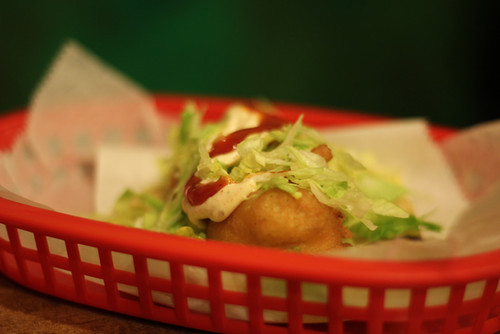
La Lagartija— West or near south side taqueria-bar, you wouldn’t say upscale but a notch up from taqueria in ambience, owned by the Bombon Bakery couple. The question with any place selling $3 tacos is, are you getting a better taco in some way for that money over the found-everywhere $2 Chicago taco, or is more money actually buying you a less interesting, gringo-safe taco? La Lagartija just manages to come in on the better side, in part because it uses good toothy Chicago tortillas like a $2 taco would. Steak and pastor tacos were all right, you can get better for $2, but you will probably eat a lot of worse ones trying to find them. The best thing, as LTHers say and they are correct, is the shrimp taco, a bit too much goo on top for my taste, but good quality shrimp lifted this above the average.
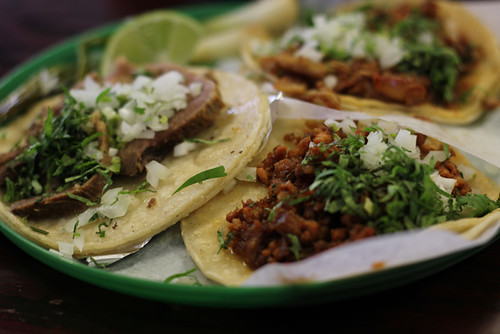
La Chapparita #1— One of the things that was cool about LTHForum back in the day was how different people would discover similar things by different methods. I went looking for Supermercado Taquerias a couple of years ago by driving down major streets looking for awnings that suggested tacos might be made inside— but I never would have found this taqueria in a grocery/candy store, on thoroughly residential 25th street, that way; instead another old-timer found it by chatting up strangers and asking for their suggestion of their favorite taco spot. But however you found it, it’s a find— a vaguely spooky Day of the Dead themed taqueria turning out beautifully well-made tacos of all kinds. I stuck to things you don’t find elsewhere (longaniza, or sausage, lengua or tongue which is served as a whole slice, not chopped, and tripas, which is actually not tripe but chitlins— you want to order them crispy) and they were all exemplary, full of flavor and executed to a T. A place like this is why good $3 tacos are worth paying for, but the great $2 tacos are a gift from the angels to us mortals.
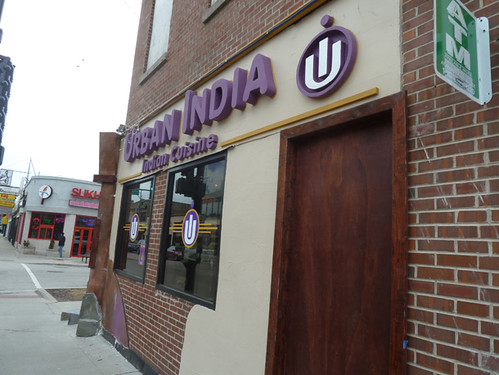
Urban India— Urban or Union is in half of new restaurant names these days, so it’s not that surprising that a new place on Devon with what looks like a little younger feel (like Uru-Swati, kind of coffeehouse-ish) would be called Urban India. The most promising thing to me was the fact that it smelled like woodsmoke— like there’s actual wood in their tandoor. There may be, but alas, it didn’t come through nearly as strongly as I would have liked on the tandoori chicken. That disappointment aside, I thought everything was pretty well made and of good quality… but it was also quite pricey for Devon ($12.95 for tandoori chicken is on the high side, but $11.95 for sag paneer, which is probably $5-8 elsewhere on the strip, is wacky; a little artfulness with the ginger hardly justifies the difference).

That’s-a-Burger— Burgers in the midwest are nearly always freshly-ground, and even an okay one in a place like Indiana or Oklahoma or Kansas is usually pretty damn good as a result. The exception to that was Chicago, where they used to nearly all be the frozen hockey-puck burger kind. The exception to that was always a small number of fresh patty places on the south east side of Chicago, both white (Top-Notch Beefburger) and black-run (That’s-a-Burger), which maybe because of proximity to Indiana, insist on fresh-ground meat against the tide of the hockey puck. With all our artisanal burger places (Edzo’s, Epic Burger, The Butcher & Burger, whatever) the need to go run and eat a burger on 71st street from a place where there’s no seating, you order through bulletproof glass, it takes an absurdly long time (about half an hour) to get your burger and the (black) owner plays rightwing talk radio really loud and will kick your ass if he catches you taking a photo, is maybe not that apparent. It’d be so much easier to just go eat a yuppie burger on Armitage, say. But trust me, you need to do this once, and then you need to go right back to your car and eat it immediately; it makes a big difference. What was I just saying about clean flavors versus Ike Turner funk? Yeah, here too. This is a burger that tastes like stockyards. Like a ten-hour shift. Like blood and onions in the air. Like Chicago, not some candy-ass yuppie burger. That’s-a-Burger, muthaf–….

Barbecued shoat.
Big Jones— This was a special dinner, not off the regular menu, but given its fair chance of making my ten-best this year, I should mention it now. The meal was the Kentucky tavern bourbon dinner, c. 1840s. I like Big Jones, I don’t necessarily think it’s great great, but it makes likable food that’s usually a pretty good example of Southern classics, and if you want fried chicken or shrimp and grits in a more upscale atmosphere than Feed or Wishbone and with a cocktail, it’s a happy, easygoing place to be. It’s also a place that seems to make things you expect to love but don’t, quite, more often than it should by now.
But chef Paul Fehribach has been digging diligently into old cookbooks for themed dinners, and the chance to make oddball, deeply uncommercial things like calves’ foot jelly seems to take Big Jones to a new level, where it doesn’t have to hit anyone’s preconceptions of “restaurant food” but can just be its own rustic, strange self. Some of these are incredibly simple (hominy, barbecued shoat or young pig), some of them reintroduce unfamiliar flavors (the surprisingly sweet calves’ foot jelly, pearl onion and mutton cream soup, a rosewater dessert). At this dinner, a few were flat-out great dishes (the mutton soup in particular) and all of it was a trip to an unfamiliar world. During the meal Fehribach was playing the Harry Smith Anthology of folk music, which collected the backwoods music of, in Smith’s words, “the old, weird America.” This was the food of the same place, and I can’t wait to go back. (Disclosure: none.)

Bourbon and calves’ jelly.
Keefer’s— I am not a steakhouse guy. I admit that freely. I do not find just a big hunk of meat accompanied by a couple of WASP vegetables (a baked potato or broccoli) to be interesting enough for a fancy meal. I went to one a while back courtesy of its PR people, and they kind of hinted at hoping I would post something, and I just thought… I have nothing to say beyond “very nice steak.” So it’s something that I actually had a couple of things at Keefer’s that motivate me to write. As my dining companion Kennyz noted, the Nantucket bay scallops were served in butter that was browned to the point of being mahagony— kudos to chef John Hogan, who many years ago had Savarin, for being willing to brown it that dark, but they were great. And we shared a veal chop, which I’ve thought of fondly many times since for the pure simple flavor of roasted meat and juicy saltiness. Other things reminded me why I’m just not into that food (the 1940s believed that a fillet of fish was improved by being stuffed with bread crumbs and crabmeat, I pretty much believe the exact opposite) but if someone were to ask me for a steakhouse recommendation, after expressing my doubts about the wisdom of asking me, I would steer them toward Hogan’s slightly more varied menu and mastery of classic American chophouse technique happily. (Disclosure: media dinner, fully comped.)
Tags: big jones, Jimmy's Pizza, Keefer's, La Chapparita #1, La Lagartija, Nha Hang, Storefront Company, That's-a-Burger, Urban India, Urban Union, YushoFor the third time in four years, I’ve been nominated for a James Beard Award for my video work. And for the first time, it’s for a solo piece rather than a multimedia nomination for a piece done in conjunction with my friends at the Chicago Reader. It’s for A Barbecue History of Chicago, my story of how Chicago’s unique barbecue style reflects and was shaped by the African American experience in this city during the 20th century. Watch it here:
Here’s my account of winning last year.
Meet three butchers who are changing the way we grow food and consume it— by finding their way back to a more traditional way of raising meat. Rob Levitt of Chicago’s The Butcher & Larder, Paul Kahan of Chicago’s Publican Quality Meats and Bartlett Durand of Black Earth Meats in Black Earth, Wisconsin are each reconnecting chefs, consumers and farmers in their own way. Butchers are hip now, and that’s part of their appeal in this video too, but it also shows that there’s more to it than that in the ways these butchers use meat to create community. (28:49)
Please note: while this video does not show slaughter, it does show plenty of meatcutting, because that’s what butchers do.
LINKS
Here’s my coverage of this video’s premiere at Uncommon Ground, at an event with FamilyFarmed.org, and here’s my post about the event at last year’s Family Farmed Expo (now renamed Good Food Festival & Conference) which inspired this video to a considerable degree, by showing me how these three guys were interrelated. (They appeared with Ellen Malloy and with Herb Eckhouse of La Quercia, who I already made a video about.) Here’s the trailer for that event.
Here are links to the three butchers featured in it:
The Butcher & Larder
Publican Quality Meats
Black Earth Meats
Paul Kahan (and two of his restaurants) were in this earlier video and this one; Rob Levitt and the restaurant he used to have were in this one.
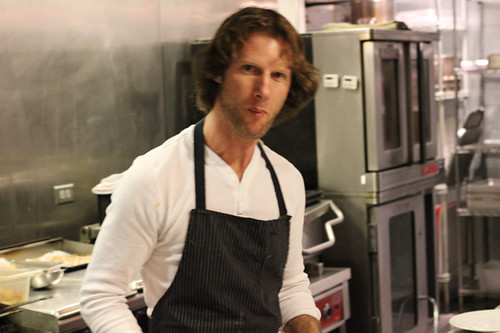
The first time I subbed for Nick Kindelsperger on Grub Street he was going through the things I needed to do the job without screwing it up, and one thing he said was “There are certain chefs who we pretty much cover anything they do.” The list was obvious enough, of chefs who were good at being endlessly interesting— Achatz, Bayless, Bowles, Izard, a couple others… and Phillip Foss.
My first thought was, one of these things is not like the others… everyone else had quite a track record by that point, but Foss was still relatively new on the scene (this was two years ago), and his food at Lockwood, though generally liked, had not catapulted him into the stratosphere of food gods per se. I had eaten at Lockwood (and then had a tangle with him online about a sloppy review written after a state of exhaustion/inebriation, quickly patched up), and it was a nice solid meal but still, you know, colored within hotel lines a bit. I wasn’t convinced he was a great chef (by any somewhat stringent definition of the term) but a good chef who was news because… he was good at making news. Asian carp. Fights with the Hilton over union slackers. Lascivious blog posts. I forget it all now, but he was brilliant at doing something fun— daring, a little naughty, delivered with a wink— that made him easy to like and fun to talk about, and made the whole scene a little more enjoyable.
So I did Grub Street for a week, wrote a small item one day about a guest stint he was doing on the Gaztro-Wagon, pre-wrote the last of my posts for Friday afternoon and scheduled them in the system, packed the car for this trip, and started driving to the east coast.
And right as we were getting on the highway, Phillip Foss was being fired by the Hilton for making a pot joke on Twitter. He had made the biggest news of my week at Grub Street, and I missed it.

If you’re reading this you surely know what has followed— first, veering downscale as the food truck pioneer of Meatyballs Mobile, then veering back very high end with EL Ideas, which was like a storefront theater version of Alinea, performed in the small sort of office space at the front of his Meatyballs prep kitchen down on an industrial nowhere stretch of the south side. I wished him well, I was as happy to feed him a little publicity as he was to get some by being the guinea pig for the test video for Key Ingredient (we shot his first, then worked it into the sequence when his friend John Des Rosiers said he’d have picked him anyway). But I wasn’t entirely sure I wanted to spend my own big bucks, Blackbird or Schwa-level if not Alinea-level bucks, for Phillip Foss’s Hey Kids, Let’s Put On A Tasting Menu— versus other places I might spend it on. Talking with others, I gathered that this was not an uncommon opinion (and later, talking with him, I gathered that this is a problem he’s had with some local critics, too— not being sure his restaurant is real enough and serious enough to be worth the investment, of time or money). Anyway, he finally wanted to treat me (disclosure) when things got a little slower in February (and Andrew Brochu, who’d been cooking with him for some months, was leaving for Graham Elliot), so I went with a group of friends on a recent Friday night.

Let me cut to the chase and say that you have nothing to fear and a lot to anticipate excitedly from EL Ideas. If it’s not a “real” restaurant, then too bad for real restaurants, because in so many ways it’s a warm and engaging experience like fine dining has often forgotten to be. I didn’t entirely buy Foss’s line of patter about the setup overlooking the kitchen space being cozier and more welcoming and erasing the barriers between the chefs and the diners, but that was, in fact, pretty much exactly what it was, and what it did; even if you don’t leave your seat and wander into the kitchen while they’re working, you have no more distance from the chefs, physically and otherwise, than you do from a friend throwing a barbecue in his backyard.
And the food, if nothing jumps out for sheer exoticism and palate-jarring novelty, is smoothly excellent, always interesting, cultivated and maybe most of all, mature. The first course, above, is called shima ajii, consisting of tuna and grated smoked bonito over tapioca— a combination that sounds like it could be hideous, frankly, like smoked chubs in cottage cheese. But it’s not— it’s creamy and smokily subtle and complex. A deconstructed caesar— who hasn’t deconstructed a caesar by now? Yet instead of being a puzzle of disconnected blocks, it was more like caesar reconstruction, putting its flavors back together out of different textures, one or two at a time.
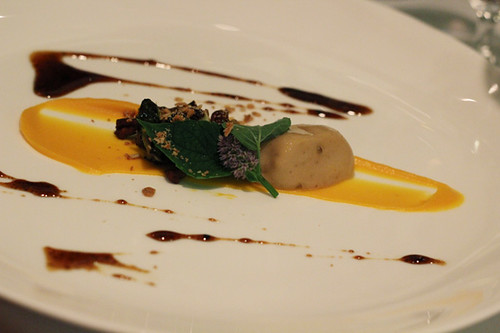
Not everything worked— buttery snails seemed beached on a dry plate of maltodextrin powder and raw cauliflower— but especially in the second half, things went from one to the next confidently and satisfyingly. Foie gras was sharpened to a point by a dash of mustard and citrusy marmalade, buddha’s hand. Fried sweetbreads and a spiral of apple added crunch and a little earthiness to lobster. Maybe the most interesting (and one that’s gotten him some attention) was called Anise Hyssop (shown above)— the one all-vegetable dish, with a root beer sauce on the plate (another thing far better than it sounds). With everything else dominated by the nature of its protein, this one was free to go somewhere unexpected, and I’d love to see him do more freeform vegetable dishes like it. Dinner came to a conclusion, finally, with a grownup take on a s’more, simple and surprisingly dignified.

The dishes flowed so harmoniously from one to the next that you might think that one mind was behind them all, but in fact each of the three chefs in the kitchen— Foss, Kevin McMullen (who also works on Crux dinners with Brandon Baltzley) and Michael DiStefano— came out and introduced the dishes they’d conceived, and between courses we occasionally wandered into the kitchen to take pictures or chat the chefs up. For all that they’re working with far fewer people than a 15-course meal normally takes, there was almost no stress in the kitchen, which was fairly remarkable, and no point where the schedule of dishes fell apart, either, which is more remarkable still.
I try a lot of upscale restaurants where I think “that was nice, done that now,” and a smaller number where I think “I want to get back and try more things” (Vera and Telegraph are the two I think of like that), but the rarest are the ones where I think I want to go back and take someone to a place, just to enjoy their enjoyment of it. There’s no place with the feel of EL Ideas, in which genially inventive food joins with a warmly welcoming and relaxed atmosphere carved out of what ought to be an impersonal, crammed-in space, and it’s a unique Chicago thing to which I would take any out of town visitor— or any critic afraid of such improvisatory dining and the perils of the near south side.


There are times I think I must be not only the most active food filmmaker in Chicago, but the world. This week was one, with three different videos turning up online and the sold-out premiere of a 4th— only the second time I’ve ever managed to have a public screening of one of my films, which usually I only get to see with my family or a friend or two. I did premiere Raccoon Stories at a party at my house with maybe 15 or 18 people, but until now the only big screening was the event Supreme Lobster planned at the Shedd Aquarium for A Better Fish and In The Land of Whitefish.
Since the new one, The Butcher’s Karma, was inspired in part by a panel* at last year’s Family Farmed Expo (now the Good Food Festival & Conference), while it was in production I contacted Grant Kessler, who describes himself as more or less the marketing guy for Familyfarmed.org (even though he’s a photographer, not a marketing guy), and he immediately liked the idea of doing an event before the festival next month premiering the video and starring the three main characters of the film. Well, by the end we didn’t have any of the three main characters for various personal reasons, but we did have a sold-out house at Uncommon Ground…

and a fine dinner prepared by Uncommon Ground chef Chris Spear from pork supplied by Black Earth Meats (plus some pate sent over by The Butcher & Larder).

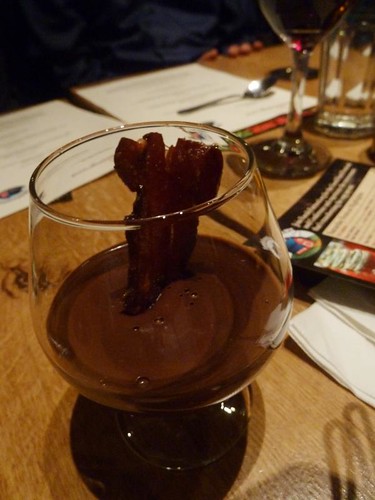
Yes, that was bacon and chocolate mousse. Anyway, a very appreciative crowd of about 60, quite a number of whom remembered the panel quite well (more than once I heard people talking about things that were said that were in the video, too); the film played after dinner and then Christopher Pax, who works for Black Earth, and I took a few questions. I’m not a personal-attention hog, but I’m not going to turn down getting applause in front of an audience, either, and this was up there with this in terms of making me feel good about the hours that go into this stuff.
So let’s see the film, you say. Well… hopefully soon. Because it involved shooting at Publican Quality Meats, which was not open yet and which had already made deals with various publications about exclusives on this or that, I have to get their signoff before it can be generally public. No question it will happen soon, it just may not happen right away. Just watch here for more details.
In the meantime, you can watch another video that I cut for Grub Street out of the footage from Publican Quality Meats. This one focuses on the store itself (which had just opened when it ran; the segment in the film is more in-depth about meat and farmers. (There’s only a tiny bit of overlap in terms of footage used between the two versions.)
But that’s not even one of the ones that premiered last week! I also shot at soon-to-be-open Nellcôte, and what I expected to be a short shoot about the unique flour mill they installed turned into a longer shoot involving actually making both pizza and pasta, so I cut it into two five-minute-ish movies:
And we’re still not done— the Key Ingredient series just keeps churning away at the Reader, and here’s the latest installment, with Iliana Regan, who does dinners in her apartment as One Sister:
Oh, and then I contributed to this Time Out Chicago bloggers’ roundup too: here, here and here.
So hopefully this quantity of material can tide you over until the 18th official Sky Full of Bacon podcast, The Butcher’s Karma, debuts. Big thanks again to Grant Kessler, Uncommon Ground (which by the way does a first rate job video-wise for a restaurant showing a movie) and FamilyFarmed.Org. And to everyone who bought tickets for the dinner… and allowed us to use the magic words “sold out.”
* I was already thinking about doing one with Bartlett Durand of Black Earth Meats, whom I’d met on a cheese junket, but the overall direction of the piece was finally set by the panel which included Rob Levitt, Paul Kahan, Durand and Herb Eckhouse of La Quercia, moderated by Ellen Malloy.
Chef Jared Van Camp makes the first pizza in Nellcôte’s word-burning oven. (6:20)